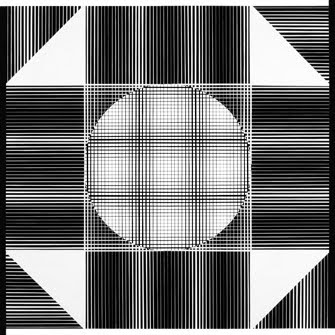Burgoyne Diller (1906-1965), Balcomb Greene (1904-1990), Gertrude Greene (1904-1956), Alice Trumbull Mason (1904-1971), Irene Rice Pereira (1902-1971), Rolph Scarlett (1889-1984), and Charles Green Shaw (1892-1974). Artists representing the 1950s and 1960s include: Richard Anuszkiewicz (b.1930), Karl Benjamin (b.1925), Lorser Feitelson (1898-1978), Sue Fuller (1914-2006), Frederick Hammersley (1919-2009), Charles Hinman (b.1932), Paul Jenkins (b.1923), John McLaughlin (1898-1976), David Smith (1906-1965), Tadasky [Tadasuke Kuwayama] (b.1935), and the Anonima Group [Ernst Benkert (b.1928), Francis Hewitt (1936-1992), and Ed Mieczkowski (b.1929)].

Explorations in Black and White: The 1930s through the 1960s brings together paintings and constructions in the reductive palette of black and white to show the developments and connections among American abstract artists over the four decades covered in the exhibition of 34 works of art. Significant artists of the 1930s and 1940s period in the exhibition include: Burgoyne Diller (1906-1965), Balcomb Greene (1904-1990), Gertrude Greene (1904-1956), Alice Trumbull Mason (1904-1971), Irene Rice Pereira (1902-1971), Rolph Scarlett (1889-1984), and Charles Green Shaw (1892-1974). Artists representing the 1950s and 1960s include: Richard Anuszkiewicz (b.1930), Karl Benjamin (b.1925), Lorser Feitelson (1898-1978), Sue Fuller (1914-2006), Frederick Hammersley (1919-2009), Charles Hinman (b.1932), Paul Jenkins (b.1923), John McLaughlin (1898-1976), David Smith (1906-1965), Tadasky [Tadasuke Kuwayama] (b.1935), and the Anonima Group [Ernst Benkert (b.1928), Francis Hewitt (1936-1992), and Ed Mieczkowski (b.1929)].
Black-and-white was the standard in communication in newspapers, television, and films into the 1960s. Painting was one of the few forms of communication that continuously involved color. Yet the suppression of color in abstract paintings of the 1930s and 1940s occurred as artists saw that a limited palette of black and white could both invigorate their compositions and end traditional elements of painting: the tonal relations within a composition which create modeling and volume and the easy distinction of figure and ground. The pioneer abstractionists discovered that with a black and white palette the compositional elements of shape, line, and texture become the focus, aiding their pursuit of a completely non-objective language. The artists of the 1950s and 1960s similarly turned to this reduced palette to bypass emotional connections with colors and present in simple push-pull compositions their experiments with placement to achieve activity and drama.
Paintings from the 1930s and 1940s like those of Burgoyne Diller (Second Theme #269, 1934) and Irene Rice Pereira (Three White Squares, 1940) fall within the cubist and geometric abstraction tradition and dialogue visually with minimal and op works of the 1960s by John McLaughlin (Untitled Composition, 1953), Frederick Hammersley (Sanforized #1, 1967), and Ernst Benkert (Warsaw #1, 1964). Other early American abstractionists worked in an organic or biomorphic Surrealist-inspired manner such as Alice Trumbull Mason. For example, the string-like lines and chunky overlapping shapes in Mason's 1945 oil Purple Median connect with the sculptural side of the exhibition. Sue Fuller's string and Plexiglas constructions of the 1950s and 1960s hang next to Purple Median allowing the viewer to envision how ideas travel from one generation to another. On the other side of the Mason hangs a 1964 David Smith spray painting, a technique he first used to visualize sculpture he might create. In the Smith spray the viewer can see affinities in texture and the play of positive and negative space with Mason's fusion of biomorphic and geometric shapes creating solids and voids.
The blocky geometric compositions of Balcomb Greene's painting Classical Forms of 1937, Gertrude Greene's painted wood construction of the same year, and Charles Green Shaw's construction Day Break of 1938 all connect visually with Charles Hinman's 1969 shaped canvas Meeting Point. These four pieces also demonstrate the progression of an idea evolving from a painting to a wall relief to a shaped canvas. Each artist has used cut-out shapes to bring tension and balance into their compositions. Greene and Shaw were considered forward-looking in their time for fusing sculpture and painting in their painted wood constructions and Hinman was equally avant-garde for presenting the shaped canvas as object in the 1960s.
The viewer also has the opportunity to see the progression within one artist's work in four paintings by John McLaughlin. The earliest painting, Untitled Composition, 1949 has a jazzy vertical punctuation which achieves push-pull within its horizontal bands of black, gray, and white. The feeling of vertical rectangles freed from the grid is continued in the black and white painting Untitled Composition, 1953. McLaughlin's elegant minimal mature style is found in two classic 42 x 60 inch canvases of the 1960s (#11, 1961 and #3, 1964). In all four McLaughlin paintings, one sees an artist ahead of his time using geometric shapes in deceptively simple, direct, and powerful arrangements.
Our exhibition of black and white abstraction also presents the opportunity to see a familiar artist's work with new perspective. The colorist Paul Jenkins has two paintings in the exhibition: Phenomena Wing Off, 1961 and Phenomena Druid Altar, 1962. Executed in a minimalist style, each brings into focus the compositional structure in Jenkins' paintings often missed by the viewer amidst the beauty of his color and technical perfection.
Through visual juxtapositions, the exhibition aims to gain greater recognition for the pioneers of American abstraction and show how the subsequent generations of artists developed stylistically different abstraction within the non-objective language set by the earlier artists. The 1930s through the 1960s is a remarkably fertile period in American art in which its artists established a complex and lively abstract movement. As teachers and inspirational practitioners, the abstract artists of the 1930s and 1940s saw America embrace pure abstraction and the 1950s and 1960s younger generation of artists become international leaders of Abstract Expressionism and the Op and Hard Edge movements.
(from the press releae of the exhibition)
No comments:
Post a Comment